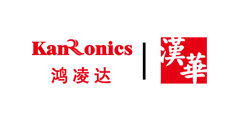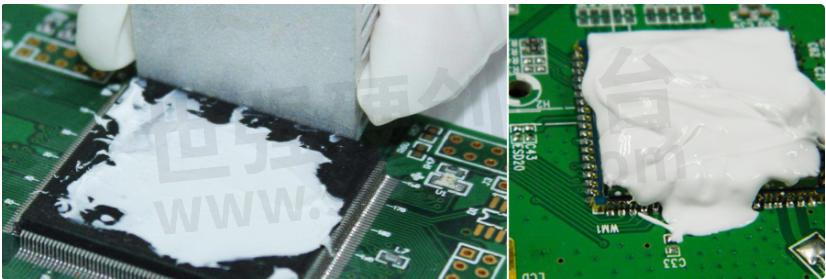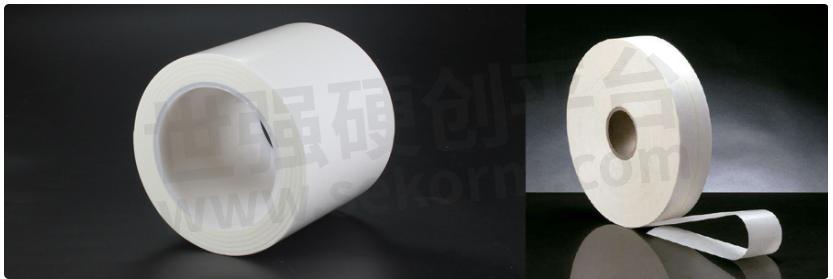Comparison of Advantages and Disadvantages of Several Common Thermal Conductive Materials

1. Thermal grease:

Thermal grease, also known as thermal grease, thermal grease, etc., is the most widely used thermal conductive medium at present. An ester-like substance formed after decompression, grinding, and other processes, the substance has a certain viscosity and no obvious graininess. It can effectively fill various gaps; in the main application environment: between high-power heating components and radiators.
advantage:
(1) Exist in liquid form with good wettability;
(2) Good thermal conductivity, high-temperature resistance, aging resistance, and waterproof properties;
(3) Insoluble in water, not easy to be oxidized;
(4) It has certain lubricity and electrical insulation;
(5) Low cost.
shortcoming:
(1) It cannot be smeared on a large area and cannot be reused;
2) The product has poor long-term stability. After continuous thermal cycles, it will cause liquid migration, leaving only the filling material, and lose surface wettability, which may eventually lead to failure;
(3) Due to the different thermal expansion rates of the materials on both sides of the interface, a "gas-filled" effect is caused, resulting in an increase in thermal resistance and a decrease in heat transfer efficiency;
(4) It is always liquid and difficult to control during processing, which is easy to cause pollution to other components and waste of materials, increasing costs.
2. Thermal pads:

Thermally conductive gaskets are used to fill air gaps between heat-generating devices and heat sinks or metal bases, their flexible, resilient characteristics allow them to be used to cover very uneven surfaces. Heat is conducted from discrete components or the entire PCB to the metal enclosure or diffuser plate, increasing the efficiency and lifespan of heat-generating electronic components.
In the use of gaskets, pressure, and temperature are mutually restrictive. With the increase in temperature, after the equipment runs for a period of time, the gasket material will soften, creep, and stress relaxation and the mechanical strength will also decrease. The pressure of the seal is reduced.
advantage:
(1) Pre-formed thermally conductive material with ease of installation, testing, and reusability;
(2) Soft and elastic, good compressibility, able to cover very uneven surfaces;
(3) It has the effect of buffering, shock absorption, and sound absorption under low pressure;
(4) Good thermal conductivity and high-grade withstand voltage insulation;
(5) Stable performance, no oil leakage at high temperatures, and high cleanliness.
shortcoming:
(1) The thickness and shape are preset, and the thickness and shape will be limited when used;
(2) The thickness of the thermally conductive silicone sheet with a thickness of less than 0.5mm is complex, and the thermal resistance is relatively high;
(3) Compared with thermal grease, the thermal conductivity of the thermal pad is slightly lower;
(4) Compared with thermal grease, thermal pads are slightly more expensive.
3. Phase change thermal conductivity material:

A phase change thermally conductive material refers to a substance that changes shape with temperature changes and can provide latent heat. The process of a phase change material from solid to liquid or from liquid to solid is called a phase change process. KY phase change thermally conductive material, with a phase change temperature of 45℃, has excellent thermal conductivity and improves the reliability of microprocessors, memory modules DC/DC converters, and power modules.
advantage:
(1) It can be repaired and reused, and the coating thickness and shape can be controlled as needed;
(2) It is solid at room temperature, but it melts to fill the micro-gap during the operation of the equipment (no vertical flow);
(3) The thermal conductivity is equivalent to the traditional thermal grease, with better performance;
(4) Excellent substitute for silicone grease, there is no phenomenon of traditional silicone grease and silicone oil volatilizing, drying, and aging;
(5) There is no glue overflow phenomenon of general silicone grease;
(6) Compared with thermal grease, there is no "inflatable" effect, and long-term use has high reliability;
(7) It can be dispensed, screen printed, and manually coated, and can be fully automated to greatly increase production;
(8) Environmentally friendly, in line with Rohs standards.
4. Thermal adhesive:

Thermally conductive adhesive, also known as thermally conductive silica gel, is made of organic silica gel as the main body, adding fillers, thermally conductive materials, and other polymer materials.
advantage:
(1) Thermal interface material, which will be cured, has adhesive properties and high adhesive strength;
(2) After curing, it is an elastic body, which is resistant to impact and vibration;
(3) The cured product has good thermal conductivity and heat dissipation function;
(4) Excellent high and low-temperature resistance and electrical properties.
shortcoming:
(1) Not reusable;
(2) The caulking gap in general.
5. Thermally conductive potting compound:

The thermally conductive potting compound is commonly divided into a silicone rubber system and an epoxy system, the silicone system is soft and elastic, and the epoxy system is hard and rigid; it can meet the requirements of a large depth of thermal conductivity potting. Improve the resistance to external vibration and improve the insulation and waterproof performance between internal components and circuits.
advantage:
(1) It has a good waterproof sealing effect;
(2) Excellent electrical properties and insulation properties;
(3) It can be disassembled and repaired after curing.
shortcoming:
(1) The heat conduction effect is general;
(4) The process is relatively complicated;
(5) poor bonding performance;
(6) The cleanliness is average.
6. Thermal tape:

Thermally conductive tape, also known as thermally conductive double-sided tape, is composed of acrylic polymer and silicone adhesive; it is usually used between low-power heat sources and small radiators to fix LED radiators, etc.
advantage:
(1) It has both thermal conductivity and adhesive properties;
(2) It has good caulking performance;
(3) The appearance is similar to double-sided tape, and the operation is simple;
(4) Generally used for some electronic parts and chip surfaces with less heat generation.
shortcoming:
(1) The thermal conductivity is relatively low, and the thermal conductivity is general;
(2) It is impossible to glue and fix heavy objects;
(3) Once the thickness of the tape is exceeded, effective heat transfer cannot be achieved with the heat sink;
(4) Once used, it is not easy to disassemble, there is a risk of damage to the chip and surrounding devices, and it is not easy to disassemble completely.
No matter which thermal conductive material can meet the needs of all electronic devices, it has more or less some of its shortcomings. The focus is on how to amplify the advantages of thermally conductive materials through product structure and various technologies.
- +1 Like
- Add to Favorites
Recommend
- Thermal Grizzly CPU Contact Frame Intel 1700 LT is Now Available
- Why Use Thermal Grease?
- Thermal Grizzly Product Update: AM5 High-Performance Heatspreader with New Nickel Plating
- The Performance and Operation Method of Thermal Grease
- Why Does Thermal Resistance Affect the Thermal Conductivity of Thermal Silicone Pad?
- New THERM-A-GAP GEL 75 Thermal Gel Offers High Thermal Conductivity and Reliability
- How to Choose from Silicone Thermal Pad and Phase Change Thermal Pad?
- Laird Thermal Systems’ PowerCycling PCX Series Thermoelectric Cooler Features a Unique Construction That Reduces Thermal Stresses in Thermal Test Sockets
This document is provided by Sekorm Platform for VIP exclusive service. The copyright is owned by Sekorm. Without authorization, any medias, websites or individual are not allowed to reprint. When authorizing the reprint, the link of www.sekorm.com must be indicated.





























































































































































































































































































































































































































































































































































































































































































































































































































































































